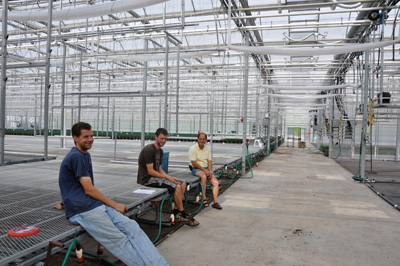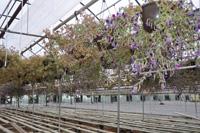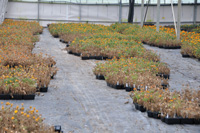
Features
Crop Culture
Inputs
Growing in the Green: Don’t wait for spring
August 31, 2010 By Melhem Sawaya
Yes, it is almost the first day of August as I am writing this article and many growers are already planning next season.
Yes, it is almost the first day of August as I am writing this article and many growers are already planning next season.
 |
|
| Reflecting on a very busy season. Advertisement
|
Here is what I saw unfold this past season, and the factors that affected the outcome. What can we learn from this season that can positively impact our next spring season?
Simply put, we had the best April sales, good May sales, and even a rainy Mothers’ Day weekend was experienced; but the shocker was a dead June.
Excellent weather in April boosted sales well above normal – by at least 25 to 30 per cent on average over other years.
The first week in May was good – still above average – but then the rainy weather on the Mother’s Day weekend put a damper on the season. This tends to happen one weekend or another every season, but you never catch up when it affects sales on the Mother’s Day weekend.
June sales experienced total sluggishness where supply significantly exceeded demand. One grower told me, after I asked about the state of the Toronto market, “Mel, if the growers are taking the product to the market in transport trucks and the buyers are coming in minivans, we are not going to sell much.”
Sales in almost every garden centre or chain store were up by five to 10 per cent with a few retailers achieving an increase of 20 to 25 per cent. A few had no growth in sales or a two to five per cent decrease in sales. I’d say that on average, sales this spring season (compared to last year) were up by five to seven per cent.
Many growers were up 10 per cent in sales; however, there were some who saw sales drop by two to five per cent. On average, grower sales were up around five per cent.
A number of growers were stuck with up to 30 per cent of their production; however, many of them are small- to medium-size operations and are growing product on speculation.
Product quality was above average this past spring.
As for product mix, fewer flats were produced; however, some growers didn’t cut back enough and ended up dumping quite a bit, including flats of impatiens. On the positive side, growers are producing more containers and most are finding homes with eager consumers.
Zonal geranium sales had their worst year, percentage-wise, compared to other genera. Maybe people realized geraniums need work (mainly dead-heading) after it rains, and if it’s not done, botrytis will take over and the plants are good only for recycling.
Marigold flats, it appears, did not sell well at all.
On average, sales of all 10-centimetre pots, of any variety, were down.
Here are some factors that impacted the outcome of this past bedding plant season.
WHAT WAS WITH THE WEATHER THIS YEAR?
■ Excellent weather in April prompted higher sales than normal and, at the same time, consumers shifted from buying the cool crops to the regular May crops earlier than usual. This also led to some growers getting stuck with cool crops such as osteospermum.
 |
|
| Even hanging baskets did not sell completely this year.
|
Almost every chain, and some independent garden centres, had low-priced hanging baskets on the Mother’s Day weekend. With the rainy weather, consumers weren’t in the mood to go out and cash in on those sales or any other bedding plant product. This led to an overstock situation in the chains’ sales areas. If plants are in the sales areas over three days, without much if any care, they will look very poor and definitely have no sales appeal. This led to a backup of “dead” product that does not sell and the store does not discard. In the meantime, further product is in the greenhouses ready to be shipped. The weather was definitely a major factor in the sales slowdown later in the season.
PRODUCT MIX
■ Bedding flat sales have been declining every year, but this year the bottom fell out. Production-wise, sales of flats were cut by 10 to 15 per cent. Some growers still ended up dumping another 10 to 20 per cent from their greenhouses. For some reason, marigold was particularly hard hit this season, perhaps because it comes in yellow, orange and white, but not in blue or purple, which are the colours for this year.
For the first time, 10" hanging baskets (HBs) were in good supply and few were dumped. This was due to the sluggish Mother’s Day sales and the volume of discounted hanging baskets on the market.
Mixed containers were still in demand and the market can still absorb good quality mixed containers at a reasonable price – that does not mean cheap.
Sales of 10 cm pots are slowing down because:
- They were overpriced.
- 15 cm pots were produced earlier in the season than other years and, compared to 10 cm pots, were reasonably priced, in my opinion.
- Consumers want an instant garden, which can be accomplished by planting 15 cm pots rather than 10 cm.
- Many homeowners are planting 25 cm (10") hanging baskets in their gardens – especially when offered at a very low price.
- There was increased production and flat demand this year because:
- There was a 20 per cent increase of product over last year in Ontario.
- Many growers increased production by five to 15 per cent.
- Less product went to the U.S. by approximately five to 10 per cent.
- Some production was switched into the Ontario market where it used to be largely into the U.S.
- The increase in production, mainly for late May and June sales, is why sales seemed slower in June. Of the 20 per cent increase, 15 per cent was targeted for June sales.
- Many weekly flowering potted plant production areas were filled with bedding plants either for themselves or contracted to other growers.
The point is there was an increase in production and slower sales were not all weather-related, though bad weather didn’t help.
SEVERAL REASONS FOR FLAT DEMAND
■ Shoving product on consumers that is not sufficiently garden-proven too often sets consumers up for failure. This turns them off gardening.
 |
|
| Tough to swallow: some spring leftovers.
|
Selling product at the wrong time is sure to frustrate retail customers. A good example is selling New Guinea Impatiens at the end of April or first week of May when they are not even 7℃ tolerant. A large percentage of consumers who start with these hanging baskets probably threw them into the garbage after two to five days; they will not buy anything else after wasting $10 to $40.
The buyers’ blind hunger to have something new and exclusive is too often leading to financial disasters for both growers and stores and, many times, to dissatisfied customers. The breeder/salesman who talked the buyer into featuring the product is not only giving untested information but is actually part of the cause of shrinking demand.
Many times, we grow a product because it is cheaper to produce than something else. However, if shelf life and garden performance are not thoroughly tested and if we continue even when we know the product is not very good, we have simply ensured a very dissatisfied consumer.
AVOID THIS YEAR’S MISTAKES WHEN PLANNING FOR 2011
■ 1. Involve your customer in planning your production schedule.
2. Do not grow exclusively for one buyer with their bar codes and packaging unless they commit to buying everything you agreed to produce for them.
3. Diversify your customer base, but test new waters carefully and on a small scale.
4. Grow well-tested cultivars that you know and trial new varieties in small numbers; new cultivars are not necessarily better than the old ones.
5. Involve your staff in the selection and planning process, especially if they have been with you a long time.
6. Remember that production numbers that are projected by your accountant or banker – or accountants for your customers – don’t mean much because sales and production are not just numbers games. Many other variables are to be considered and only the close relationship of you and your outlet store/independent garden centre allows you to know the mechanics to determine the potential for increasing the business.
7. Sales projections based on the need to pay a mortgage or buy a new toy normally backfire badly. Base production numbers only on orders or on your customers’ potential sales capacities, all information that you learned through years of dealing with your customers.
8. Only grow what can fit – properly spaced – right away. Growing to re-space later could and will backfire badly when:
- a. Product doesn’t go out on time.
- b. You face a labour crunch during shipping and spacing.
- c. You experience poor quality because you cannot space appropriately, or the product was grown under a canopy of hanging baskets that should have been shipped a week or two ago.
9. Plan your product mix and order early.
10. Profitable mixed containers should be planned and not just planted using whatever is around.
- a. Two to three varieties per mix is good enough.
- b. Use compatible varieties so that one will not overgrow the others.
- c. Experiment with fewer cuttings per container. Many times, you will not see the difference and you will get a product with improved shelf life and a better chance of survival for the consumer.
11. It is OK to run out of product, but disastrous to dump plants. Losing a sale means you lost only the margin you would have made; depending on your production, this varies from five to 15 per cent. However, based on your profit margin, every dollar of dumped product actually eats up $15 to $20 in sales. Dumping $1,000 worth of plants actually takes away the profit on your $15,000 to $20,000 in sales.
CONCLUSIONS
■ Grow what you can sell and avoid dumping plants. This is the basis for:
- Prices staying up because there is no pressure to drop prices.
- Ensuring dumping doesn’t eat up 15 to 20 times the profit you made on your sales.
Educate, listen and work with your customers and employees. Be your company’s coordinator who keeps all aspects running harmoniously and interacting together. Bullying and bossing people around might get the job done, but it will not build a successful business. Building a team that cannot wait until Monday to come to work, rather than one only waiting for Friday when they can leave for the week, is the basis for a successful business.
I always say that, “if your job and everyone else’s job is a hobby, then you don’t have to work the rest of your life!” ■
Melhem Sawaya of Focus Greenhouse Management is a consultant and
research coordinator to the horticultural industry. Comments on this or
any other article are always welcome; please e-mail
mel@focusgreenhousemanagement.com , or visit www.focusgreenhousemanagement.com or www.sawayagardentrials.ca .
Print this page